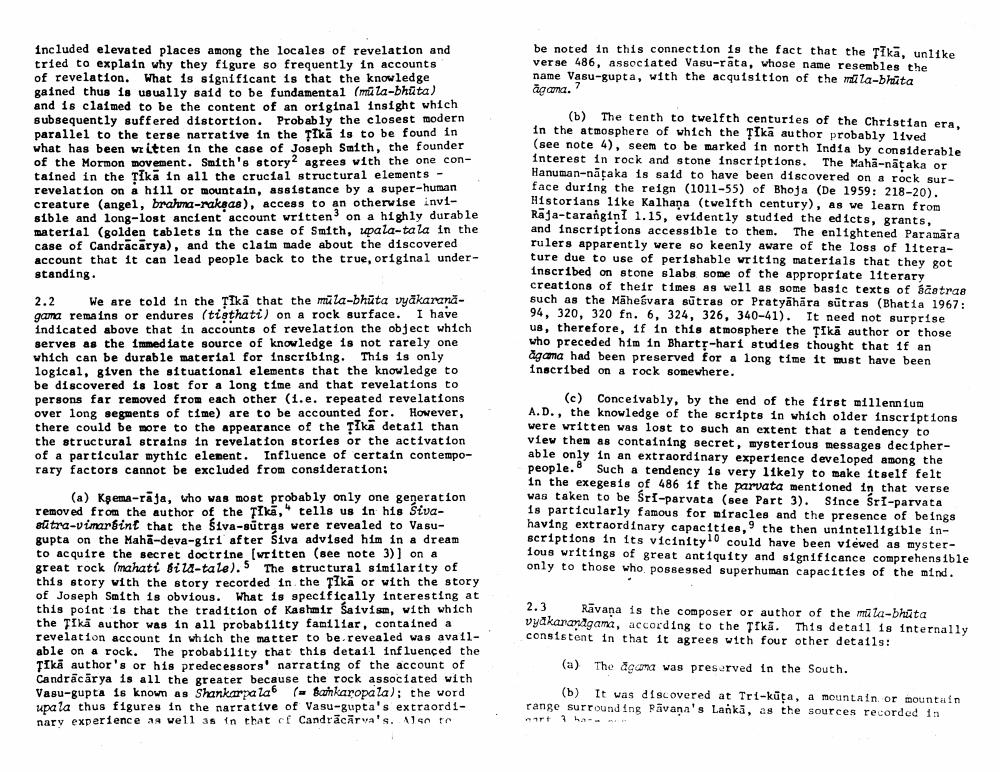Book Title: Interpreting Vakyapadiya 2486 Historically Author(s): Ashok Aklujkar Publisher: Ashok Aklujkar View full book textPage 2
________________ be noted in this connection is the fact that the Tłka, unlike verse 486, associated Vasu-rata, whose name resembles the name Vasu-gupta, with the acquisition of the mla-bhata agcona.? included elevated places among the locales of revelation and tried to explain why they figure so frequently in accounts of revelation. What is significant is that the knowledge gained thus is usually said to be fundamental (mala-bhūta) and is claimed to be the content of an original insight which subsequently suffered distortion. Probably the closest modern parallel to the terse narrative in the TIkā 1s to be found in what has been weltten in the case of Joseph Smith, the founder of the Mormon movement. Smith's story agrees with the one contained in the Tika in all the crucial structural elements - revelation on a hill or mountain. assistance by a super-human creature (angel, brahma-raksas), access to an otherwise invisible and long-lost ancient account written on a highly durable material (golden tablets in the case of Smith, wala-tala in the case of Candrācārya), and the claim made about the discovered account that it can lead people back to the true, original understanding (b) The tenth to twelfth centuries of the Christian era, in the atmosphere of which the pika author probably lived (see note 4), seem to be marked in north India by considerable interest in rock and stone inscriptions. The Mahā-nātaka or Hanuman-nataka is said to have been discovered on a rock surface during the reign (1011-55) of Bhoja (De 1959: 218-20). Historians 11 ke Kalhaņa (twelfth century), as we learn from Raja-tarangini 1.15, evidently studied the ed icts, grants, and inscriptions accessible to them. The enlightened Paramāra rulers apparently were so keenly aware of the loss of literature due to use of perishable writing materials that they got inscribed on stone slabs some of the appropriate 11terary creations of their times as well as some basic texts of biotras such as the Māheśvara sutras or Pratyahāra sūtras (Bhatia 1967: 94, 320, 320 fn. 6, 324, 326, 340-41). It need not surprise us, therefore, 1f in this atmosphere the ȚIkā author or those who preceded him in Bhartr-hari studies thought that if an agama had been preserved for a long time it must have been inscribed on a rock somewhere. 2.2 We are told in the Tikā that the mula-bhūta vyakaranagama remains or endures (tisthati) on a rock surface. I have indicated above that in accounts of revelation the object which serves as the immediate source of knowledge is not rarely one which can be durable material for inscribing. This is only logical, given the situational elements that the knowledge to be discovered is lost for a long time and that revelations to persons far removed from each other (1.e. repeated revelations over long segments of time) are to be accounted for. However, there could be more to the appearance of the Tikā detail than the structural strains in revelation stories or the activation of a particular mythic element. Influence of certain contemporary factors cannot be excluded from consideration: (c) Conceivably, by the end of the first millennium A.D., the knowledge of the scripts in which older inscriptions were written was lost to such an extent that a tendency to view them as containing secret, mysterious messages decipherable only in an extraordinary experience developed among the people. Such a tendency is very 11kely to make itself felt in the exegesis of 486 1f the parvata mentioned in that verse was taken to be Sri-parvata (see Part 3). Since Sri-parvata 1s particularly famous for miracles and the presence of beings having extraordinary capacities, the then un intelligible inscriptions in its vicinity! could have been viewed as myster1ous writings of great antiquity and significance comprehensible only to those who possessed superhuman capacities of the mind. (a) Kema-raja, who was most probably only one generation removed from the author of the TIkā," tells us in his Sivasūtra-vimarsint that the Siva-sútres were revealed to Vasugupta on the Maha-deva-girt after Siva advised him in a dream to acquire the secret doctrine (written (see note 3)] on a great rock (mahati sila-tale). S The structural similarity of this story with the story recorded in the Tika or with the story of Joseph Smith is obvious. What is specifically interesting at this point is that the tradition of Kashmir Saivism, with which the Tikā author was in all probability familiar, contained a revelation account in which the matter to be revealed was available on a rock. The probability that this detail influenced the TIkā author's or his predecessors' narrating of the account of Candrācārya is all the greater because the rock associated with Vasu-gupta is known as Shankarpala (= Bankaropala); the word upala thus figures in the narrative of Vasu-gupta's extraordinary experience as well as in that of Candrācārva's. 1 st 2.3 Rāvana is the composer or author of the mula-bhata vyakaranagama, according to the trka. This detail is internally consistent in that it agrees with four other details: (a) The agua was preserved in the South. (b) It was discovered at Tri-kūța, a mountain or mountain range surrounding Pāvana's Lanka, as the sources recorded inPage Navigation
1 2 3 4 5 6
